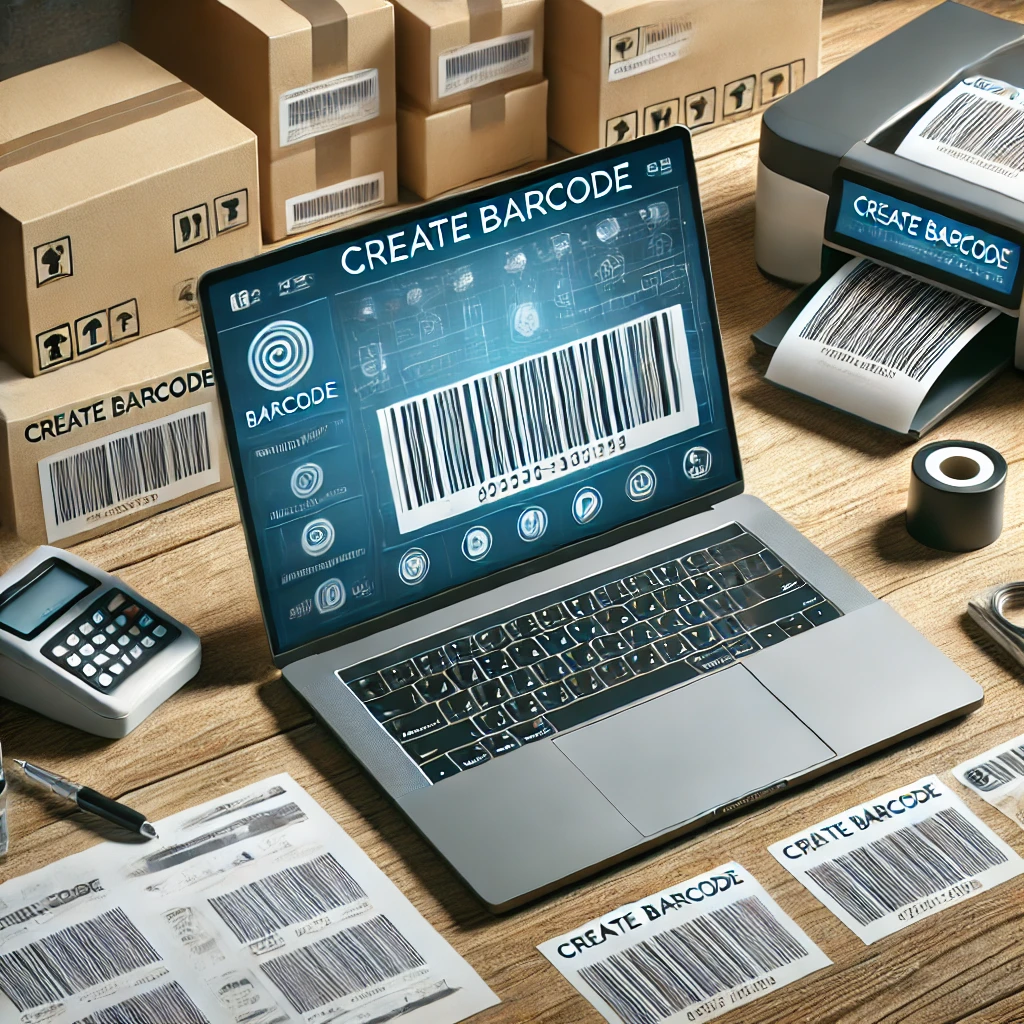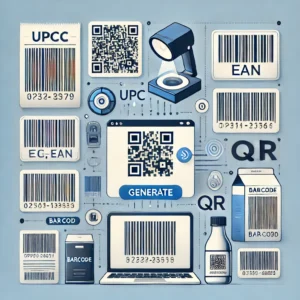
How to Create Barcode: Step-by-Step for Businesses
The development of barcodes is now a completely integrated part of modern business practices, helping businesses streamline operations, lessen errors,

The development of barcodes is now a completely integrated part of modern business practices, helping businesses streamline operations, lessen errors, and become organized in managing an inventory. The following guide takes you through in-depth how to create barcode, the tools needed, and how to implement a barcode system that can revolutionize your processes.
With the advancement of barcode generator software, small businesses have now easily embraced barcodes. It does not require highly technical knowledge. Everything relating to how you can produce UPC barcodes and what kind of barcode software would suit your needs will be discussed.
It began as a pursuit to make it easier and even simpler to manage inventory and track products for businesses. Before there were barcodes, each item was checked by a human, then recorded and tracked, which is extremely time-consuming and error-prone to anyone. Barcodes encode the information that would have been written individually about a product into simple patterns readable by a machine. To understand the basics of barcodes, check out what is a barcode: A complete guide.
Now, whether it is a warehouse management system or a retail business, barcodes have implanted the seed that will grow into an error-free, more efficient system. It minimizes the time it takes to be manually entered and ensures much more accurate data handling in your operations. Learn how to get the right barcode billing software for an efficient workflow and improved accuracy.
Create barcodes for your products or business operations isn’t that complicated as may be imagined. Follow this step-by-step guide on how to generate a barcode to ensure accuracy and proper implementation.
Barcodes are available in many formats, adapted for application in different industries. It is essential to understand what kind of barcode you are going to need:
UPC (Universal Product Code): For retail, this is the barcode of choice, and you need it if your product is to be sold by a retailer. If you’re wondering about its importance in retail, read more on UPC codes and their importance in retail businesses.
QR Code: These are great and are very versatile. For more details on how QR codes differ from other similar technologies, refer to this comparison of QR codes vs. Data Matrix codes.
Code 39 or Code 128: These are greatly used in logistics and manufacturing, as more significant data sets may be stored, and are perfect for tracking products or shipments.
Once you identify your needs in a barcode, it’s time to make a selection of the correct barcode generation software. For a comprehensive overview, check out choosing the best invoicing and billing software to integrate with your barcode system. There are many on offer, each carrying different features. Among the most popular barcode software tools, online barcode generators and other tools, including the following, can be noted:
Online barcode generators: Online barcode generators are good for small-sized businesses requiring a quick solution. You can easily input product data and immediately generate a barcode.
Full barcode systems: These consist of sophisticated software that can link with an inventory management or POS system. They are best suited for larger businesses that need to keep track of large numbers of products.
Barcode generator software makes it simple to create barcode. You don’t have to know how to code in order to use this software as most are designed to be user friendly and accessible to even a programmer novice, so you can simply design your barcode using the following simple steps:
After you select your software, the next step is to actually design the barcodes. You typically use one of the following methods:
Input your product name, price, and SKU number.
Select any orientation of the barcode you prefer: UPC, QR code, anything.
Adjust the size and resolution according to how you are going to print on the packaging, shipping labels, etc.
Most barcode generator software will also enable you to download the barcode in a printable format such as PNG or SVG which you can easily insert into your packaging design or labels.
Up to this point, you have only create barcode, and that is only half the fight-you also have to implement barcodes into the whole operations. This is where the barcode system comes in. A barcode system comprises:
Barcode scanners: These are what scan the barcodes and transmit the information to your system.
Inventory management software: This is where the information from the barcodes will be saved and the inventory can be updated in real time, shipments followed, and sales processed.
You would really increase your workflow by getting a barcode system. For example, when it comes to a warehouse, you can use this to help workers scan items as they enter and leave, meaning that the inventory will be up to date in real time.
Once you have create a barcode and implemented your barcodes, test them to ensure they meet standards. Verify that the scanners are decoding the barcodes correctly and validate the information encoded is correct. Occasionally, assess and refine your barcode system to ensure it remains adequate for your business.
One of the most familiar barcodes used is the UPC barcode, which businesses in the retail industry should have. All countries standardize it, so if you plan to sell through third-party retailers or big-box stores, you must have it. Here’s the general process by which one can acquire UPC barcodes:
Retailers use UPC barcodes because they are universally recognized and scan on all standard retail barcode scanners.
Effective generation of barcodes and management of inventory requires proper selection of the appropriate barcode software. The parameters are as follows.
Ease of Use: The software should have an easy-to-use interface for even the non-technical user.
Integration Capabilities: Choose software with integration capabilities that easily links to inventory management or POS systems, eliminating the need to transcribe data.
Customization: Some of the software allows the size, format, and data enclosed in your barcodes to be customizable for use in different applications.
Find the ones that support the most commonly used barcode formats such as UPCs, EANs, and QR codes; therefore, you will surely find something that will meet your needs.
Knowing when to deploy a barcode system can be the difference between business efficiency and frustration. If you notice complications or errors in your inventory management process, consider using barcodes. Some of the crucial signs include:
Frequent Occurrence of Inventory Errors: Miscounts, misplaced items, or lost products signal it’s time to have higher accuracy tracking going on.
When business is expanding, then it’s not effective to track inventory. A barcode system does this automatically.
The Delays in Processing Orders: In case the order processing is going to take much time owing to stock tracking then the barcode system can speed up the processes, and real-time updates regarding the stock level and accuracy of the order.
High Operational Costs: A barcode system will reduce labor-intensive processes because it reduces costs associated with human error, inventory loss, and other manual data-entry costs.
A barcode system is important to your business if you need efficiency, accuracy, and automation in maintaining or scaling your operations.
You can generate a barcode for your business in several ways. Each type has its merits depending on the scope and extent of your operations:
It is the most simple and easy method. You can use free or paid online tools that enable you to input the data and generate a barcode instantly. This method is suitable for small businesses or businesses that really need an urgent quick solution.
For high-volume businesses, the good investment would be professional barcode generator software. Such software offers options like generating and managing a barcode in bulk quantities with possible configurations for size, format, and data integration.
If you’re managing inventory or products with Excel, then there are barcode add-ins that allow you to turn your product data directly into barcodes from your spreadsheets. This is a particularly very practical option if the business already works with spreadsheets for inventory management.
Many companies print their barcodes using specialized label printers. This gives them much more control over design, material, and size. You’ll need a upfront investment in equipment and supplies, though.
Whether you print your barcodes or have them pre-printed for you, it’s crucial to ensure that they scan properly to keep your system operational.
Installing a barcode system benefits a company in numerous ways; however, when a company starts automation for the first time, it faces several challenges. Some of the key areas of concern are:
Initial Investment: Buying scanners, printers, and software initially costs more, but over the long term, you offset this expense with the benefits.
Employee Training: Train employees to use the barcode technology effectively. Effective onboarding prevents disruptions in business operations.
System Integration: Barcode technology might require IT skills for its integration into already operational business systems such as ERP or warehouse management software.
Preparation of these kinds of challenges will ensure that there is a smooth roll-out of barcode technology in businesses.
Barcode software offers great flexibility and control of your process for creating barcodes. Some of the most important benefits include:
Personalization Many software solutions allow you to personalize format, dimension, and data encoding for your barcodes depending on business needs.
Generate Hundreds of Barcodes at Once: If you are dealing with large quantities of products, you will be able to print hundreds of barcodes at once using the barcode generation software. You can save time to do other things.
Integration with Other Systems: Barcode software can easily integrate with most inventory management systems. This allows you to effectively update your stock level and track products’ movements in real-time.
Minute Possibility of Human Error: Since automation minimizes the likelihood of human error, the data you encode into your barcodes will be accurate and valid.
Investing in barcode software ensures that your business will easily manage the generation of barcodes and also the handling of its inventory, hence boosting productivity.
Knowing how to produce barcodes and having a barcode system is fundamental to business people who want to streamline their operations. To generate UPC barcodes for retail or for internal use, invest in the best barcode generator software to make the process easy and efficient.
By incorporating barcodes into your business, you are indeed sowing the seed that will eventually blossom into a more streamlined, efficient, and cost-saving operation. From inventory management to smoother processes at the checkout counter, the ability to create barcode systems plays a critical role in modern businesses.

The development of barcodes is now a completely integrated part of modern business practices, helping businesses streamline operations, lessen errors,

Sarcodes are responsible for changing the inventory management skills within businesses, tracking products, and improving their operational efficiency. Whether you

Street No 5, Opp. Mohar Singh Hospital, Hisar Rd, Bus Stand Sirsa, Haryana
+919050073902
